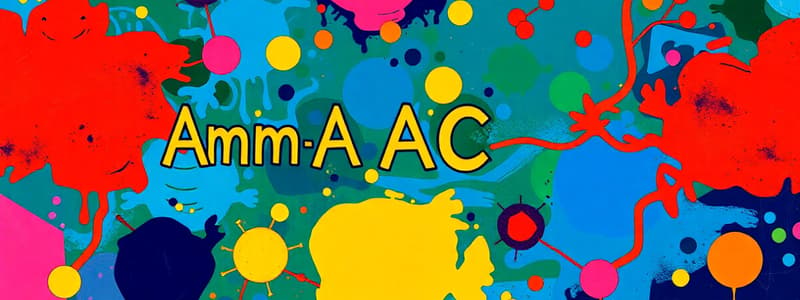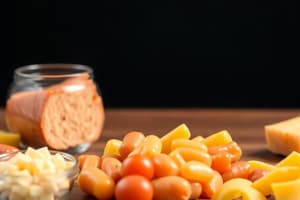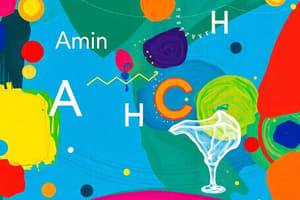Podcast
Questions and Answers
What is the initial step in amino acid catabolism?
What is the initial step in amino acid catabolism?
- Removal of the amino group (correct)
- Removal of the carboxylic group
- Conversion to glucose
- Conversion to fatty acids
Which molecule is primarily involved in nitrogen metabolism during amino acid catabolism?
Which molecule is primarily involved in nitrogen metabolism during amino acid catabolism?
- Alanine
- Glutamate (correct)
- Aspartate
- Serine
How do aquatic vertebrates primarily excrete nitrogen?
How do aquatic vertebrates primarily excrete nitrogen?
- As ammonium ions in urine
- As urea through kidneys
- As uric acid through the gastrointestinal tract
- As ammonia through diffusion or active transport (correct)
Why do many terrestrial vertebrates excrete nitrogen in the form of urea?
Why do many terrestrial vertebrates excrete nitrogen in the form of urea?
What is a significant advantage of excreting nitrogen as uric acid for birds and reptiles?
What is a significant advantage of excreting nitrogen as uric acid for birds and reptiles?
What indicates liver dysfunction when elevated?
What indicates liver dysfunction when elevated?
Which process involves the transformation of ammonia into urea?
Which process involves the transformation of ammonia into urea?
What form of nitrogen is measured by BUN?
What form of nitrogen is measured by BUN?
How is ammonia typically transported in the bloodstream?
How is ammonia typically transported in the bloodstream?
Which enzyme is responsible for removing ammonia from glutamate?
Which enzyme is responsible for removing ammonia from glutamate?
What component of liver function tests is represented as SGOT?
What component of liver function tests is represented as SGOT?
Which electron acceptor can be used in oxidative deamination?
Which electron acceptor can be used in oxidative deamination?
In what cell organelle does oxidative deamination occur?
In what cell organelle does oxidative deamination occur?
Which of the following amino acids is classified as both nonessential and conditionally essential?
Which of the following amino acids is classified as both nonessential and conditionally essential?
What percentage of the body’s energy production is accounted for by the catabolism of amino acid carbon skeletons?
What percentage of the body’s energy production is accounted for by the catabolism of amino acid carbon skeletons?
Which of the following amino acids is considered essential?
Which of the following amino acids is considered essential?
Which group of amino acids is primarily needed in young, growing animals or during illness?
Which group of amino acids is primarily needed in young, growing animals or during illness?
Which amino acids are part of the acronym PVT TIM HALL, representing essential amino acids?
Which amino acids are part of the acronym PVT TIM HALL, representing essential amino acids?
What is azotemia typically associated with?
What is azotemia typically associated with?
What is the primary role of transaminations in the metabolism of amino acids?
What is the primary role of transaminations in the metabolism of amino acids?
Why is excess NH3 particularly harmful to the brain?
Why is excess NH3 particularly harmful to the brain?
Which treatment is effective in reducing ammonia levels associated with asterixis?
Which treatment is effective in reducing ammonia levels associated with asterixis?
Which cofactor is essential for the enzymatic transamination process?
Which cofactor is essential for the enzymatic transamination process?
What happens to glutamate levels in the brain during liver failure?
What happens to glutamate levels in the brain during liver failure?
What is the result of the transamination of α-ketoglutarate?
What is the result of the transamination of α-ketoglutarate?
What process occurs due to excess glutamate in the brain?
What process occurs due to excess glutamate in the brain?
Which amino acid is specifically involved in the reaction catalyzed by alanine transaminase (ALT)?
Which amino acid is specifically involved in the reaction catalyzed by alanine transaminase (ALT)?
Which of the following is a temporary storage of nitrogen generated from transamination reactions?
Which of the following is a temporary storage of nitrogen generated from transamination reactions?
What is the primary amino acid used to detoxify ammonia in the brain?
What is the primary amino acid used to detoxify ammonia in the brain?
What neurological symptom is associated with ammonia toxicity?
What neurological symptom is associated with ammonia toxicity?
Which enzymes are primarily monitored to assess liver function?
Which enzymes are primarily monitored to assess liver function?
The glucose-alanine cycle is most active in which type of muscle condition?
The glucose-alanine cycle is most active in which type of muscle condition?
What substance is typically accepted by α-ketoglutarate during transamination?
What substance is typically accepted by α-ketoglutarate during transamination?
What main factor contributes to the conversion of excess glutamate into GABA?
What main factor contributes to the conversion of excess glutamate into GABA?
What happens to L-glutamate when nitrogen is needed for amino acid biosynthesis?
What happens to L-glutamate when nitrogen is needed for amino acid biosynthesis?
Which of the following correctly describes NH4+ in relation to membranes?
Which of the following correctly describes NH4+ in relation to membranes?
Which mechanism is described as using a ping-pong model in transaminations?
Which mechanism is described as using a ping-pong model in transaminations?
What is the byproduct formed when alanine is converted into pyruvate?
What is the byproduct formed when alanine is converted into pyruvate?
Why is free ammonia considered toxic?
Why is free ammonia considered toxic?
What type of reaction does alanine transaminase perform?
What type of reaction does alanine transaminase perform?
What does L-glutamate regenerate during the reverse reaction of transamination?
What does L-glutamate regenerate during the reverse reaction of transamination?
What is the primary role of alanine in the transport of substances to the liver?
What is the primary role of alanine in the transport of substances to the liver?
Which enzyme initiates the conversion of ammonia into carbamoyl phosphate in the urea cycle?
Which enzyme initiates the conversion of ammonia into carbamoyl phosphate in the urea cycle?
Which of the following is true regarding the urea cycle?
Which of the following is true regarding the urea cycle?
What is the function of glutamate in the context of ammonia transport?
What is the function of glutamate in the context of ammonia transport?
What byproduct is generated from the urea cycle along with the production of urea?
What byproduct is generated from the urea cycle along with the production of urea?
In the urea cycle, which enzyme facilitates the conversion of argininosuccinate into arginine?
In the urea cycle, which enzyme facilitates the conversion of argininosuccinate into arginine?
Which amino acids must be obtained through dietary sources?
Which amino acids must be obtained through dietary sources?
What happens to ammonia after it is generated in mitochondria?
What happens to ammonia after it is generated in mitochondria?
Flashcards
Amino Group Removal
Amino Group Removal
The process of removing amino groups from amino acids during catabolism.
Transamination
Transamination
Transfer of an amino group from an amino acid to a keto acid, creating a new amino acid and keto acid.
Aminotransferases
Aminotransferases
Enzymes that catalyze transamination reactions.
Pyridoxal Phosphate (PLP)
Pyridoxal Phosphate (PLP)
Signup and view all the flashcards
α-ketoglutarate
α-ketoglutarate
Signup and view all the flashcards
L-glutamate
L-glutamate
Signup and view all the flashcards
Alanine Transaminase (ALT)
Alanine Transaminase (ALT)
Signup and view all the flashcards
Liver Function Tests
Liver Function Tests
Signup and view all the flashcards
Transaminase Ping-Pong
Transaminase Ping-Pong
Signup and view all the flashcards
Liver Enzymes
Liver Enzymes
Signup and view all the flashcards
ALT and AST
ALT and AST
Signup and view all the flashcards
SGOT/SGPT
SGOT/SGPT
Signup and view all the flashcards
Transaminases (AST/GOT)
Transaminases (AST/GOT)
Signup and view all the flashcards
Ammonia Transport
Ammonia Transport
Signup and view all the flashcards
Glutamine
Glutamine
Signup and view all the flashcards
Glutamate Dehydrogenase
Glutamate Dehydrogenase
Signup and view all the flashcards
Oxidative Deamination
Oxidative Deamination
Signup and view all the flashcards
Urea
Urea
Signup and view all the flashcards
Transdeamination
Transdeamination
Signup and view all the flashcards
Blood Urea Nitrogen (BUN)
Blood Urea Nitrogen (BUN)
Signup and view all the flashcards
Ammonia toxicity
Ammonia toxicity
Signup and view all the flashcards
Asterixis
Asterixis
Signup and view all the flashcards
Glutamate
Glutamate
Signup and view all the flashcards
Glutamine
Glutamine
Signup and view all the flashcards
Ammonia detoxification
Ammonia detoxification
Signup and view all the flashcards
Urea cycle
Urea cycle
Signup and view all the flashcards
Hyperammonemia
Hyperammonemia
Signup and view all the flashcards
Lactulose
Lactulose
Signup and view all the flashcards
Hepatic encephalopathy
Hepatic encephalopathy
Signup and view all the flashcards
Pyruvate Conversion
Pyruvate Conversion
Signup and view all the flashcards
Alanine Transport
Alanine Transport
Signup and view all the flashcards
Alanine to Pyruvate
Alanine to Pyruvate
Signup and view all the flashcards
Glutamine Transport
Glutamine Transport
Signup and view all the flashcards
Carbamoyl Phosphate
Carbamoyl Phosphate
Signup and view all the flashcards
Urea Cycle Enzymes
Urea Cycle Enzymes
Signup and view all the flashcards
Urea Cycle ATP
Urea Cycle ATP
Signup and view all the flashcards
Essential Amino Acids
Essential Amino Acids
Signup and view all the flashcards
Amino Acid Catabolism
Amino Acid Catabolism
Signup and view all the flashcards
NH4+
NH4+
Signup and view all the flashcards
α-keto acids
α-keto acids
Signup and view all the flashcards
Central Metabolism
Central Metabolism
Signup and view all the flashcards
Liver's role in Nitrogen Metabolism
Liver's role in Nitrogen Metabolism
Signup and view all the flashcards
Urea
Urea
Signup and view all the flashcards
Uric Acid
Uric Acid
Signup and view all the flashcards
Glutamine
Glutamine
Signup and view all the flashcards
Glutamate
Glutamate
Signup and view all the flashcards
Alanine
Alanine
Signup and view all the flashcards
Aspartate
Aspartate
Signup and view all the flashcards
Nitrogenous waste
Nitrogenous waste
Signup and view all the flashcards
Ammonia Excretion
Ammonia Excretion
Signup and view all the flashcards
Plant Nitrogen Conservation
Plant Nitrogen Conservation
Signup and view all the flashcards
Essential Amino Acids
Essential Amino Acids
Signup and view all the flashcards
Nonessential Amino Acids
Nonessential Amino Acids
Signup and view all the flashcards
Conditionally Essential Amino Acids
Conditionally Essential Amino Acids
Signup and view all the flashcards
Amino Acid Degradation
Amino Acid Degradation
Signup and view all the flashcards
Energy Production
Energy Production
Signup and view all the flashcards
Study Notes
Amino Acid Catabolism and Urea Production
- Amino acid catabolism occurs during normal protein degradation/synthesis (protein turnover) within cells, recycling amino acids into new proteins. Excess amino acids are also catabolized.
- Catabolism also happens when animals rely solely on meat (carnivores) or when the diet provides more amino acids than the body needs for protein synthesis.
- Starvation and uncontrolled diabetes mellitus also cause amino acid catabolism, as carbohydrates are unavailable.
Dietary Protein Digestion
- Food triggers gastric mucosa cells to release gastrin, stimulating HCl secretion by parietal cells and pepsinogen secretion by chief cells.
- Pepsinogen is converted into pepsin at low pH (1.5-2).
- Pepsin breaks down proteins into peptides in the stomach.
- Trypsin and chymotrypsin further break down proteins and peptides into smaller peptides in the small intestine.
- Aminopeptidase and carboxypeptidases A and B in the small intestine break down peptides into amino acids which are absorbed.
Amino Acid Catabolism Pathways
- Absorbed amino acids are used for making new proteins or for energy.
- Amino acids are first converted to ammonia (NH4+) and a-keto acids (carbon skeletons), which are then further catabolized.
- Excess amino acids are sent to the liver for catabolism, transporting ammonia.
- Ammonia is reused or excreted as urea or uric acid.
- Glutamate, glutamine, alanine and aspartate are crucial for nitrogen metabolism. They are easily converted into TCA intermediates (a-ketoglutarate, pyruvate, oxaloacetate).
Ammonia Handling and Transport
- Free ammonia is toxic and cannot be released directly into the bloodstream.
- Ammonia is recycled by converting it into glutamine.
- Excess ammonia is transported to the liver (and to a lesser degree to specialized cells in small intestine and kidneys) via glutamine.
- Glutamine is converted into urea for excretion.
Enzymatic Transamination
- Transamination: transfer of an amino group from an amino acid to a-ketoglutarate, producing glutamate.
- Aminotransferases (also called transaminases) catalyze this reaction.
- Pyridoxal phosphate (vitamin B6) is a cofactor required for these enzymes.
- Glutamate acts as a temporary storage of nitrogen.
Urea Cycle
- Ammonia is first converted into carbamoyl phosphate, by CPS1 in mitochondria.
- The urea cycle is a series of reactions converting ammonia into urea.
- Key enzymes in the urea cycle include carbamoyl-phosphate synthetase I (CPS1), ornithine transcarbamoylase (OTC), ornithine-transcarbamoylase, argininosuccinate synthetase, argininosuccinase, and arginase.
Essential vs. Nonessential Amino Acids
- Essential amino acids must be obtained from the diet, while nonessential amino acids can be synthesized by the body.
- Some amino acids are conditionally essential under specific conditions, like growth, illness or specific metabolic needs (example: arginine).
Amino Acid Degradation Pathways
- Catabolism pathways for various amino acids that eventually feed into the central metabolic pathways like the Krebs cycle
- There are also specific pathways for some amino acids that can branch off into different pathways.
- Some amino acids have both glucogenic and ketogenic pathways, meaning their carbon skeletons can be used to make glucose or ketone bodies.
Ammonia Toxicity
- Ammonia is toxic to the brain.
- High levels of ammonia can lead to hyperammonemia, causing neurological problems (hepatic encephalopathy), asterixis (liver flap), and coma.
- Treatment strategies for high ammonia levels involve managing the underlying cause (like liver failure), and possibly using lactulose to remove ammonia through the intestines.
Clinical Aspects of Amino Acid Metabolism
- Liver enzyme tests (ALT and AST) are used to assess liver function and diagnose liver disease or damage.
- Genetic disorders affecting amino acid catabolism can cause a variety of symptoms (e.g., inborn errors of metabolism).
- These disorders often have specific characteristic features, which can be used for diagnosis and treatment options.
Studying That Suits You
Use AI to generate personalized quizzes and flashcards to suit your learning preferences.
Related Documents
Description
This quiz explores the processes of amino acid catabolism and urea production, including their significance during normal metabolism and under specific dietary conditions such as carnivory and starvation. It also covers the digestion of dietary proteins in the stomach and small intestine, detailing enzyme functions and pH levels involved. Test your knowledge on these vital biochemical processes!




